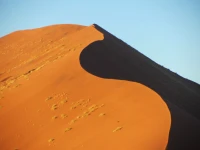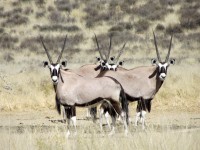Something one often forgets is that country borders are arbitrary, man-made features. Often running along natural geographic features such as rivers and mountain ranges. Sometimes literally just being lines drawn in the sand after territory was fought over and claimed. Being at the tip of Africa, South Africa has a very long coastline (some 2800 kms) and no immediate neighbouring countries to the west, south and most of the east of it. North of South Africa is a different story with the neighbouring countries of Namibia, Botswana, Zimbabwe and Mozambique. As well as the two small kingdoms of Lesotho and Swaziland which lie within South Africa. What this means is a lot of border posts. The main border posts going into Zimbabwe, Mozambique and Botswana are extremely busy and tend to look like this . . .

South African - Mozambique border at Komatipoort ©Kobus Venter
Queues at border posts sometimes stretch a couple of kilometres, and waiting times can be as long as three hours. See the post Chicken run to Pomene.

Map of South Africa showing area (in green) covered by Kgalagadi Transfrontier Park. Image: Wikimedia Commons.
The Southern African side of Kgalagadi Transfrontier Park (KTP) is a triangular sliver of land in the Northern Cape Province of South Africa, and is wedged between Namibia and Botswana. The border posts from the KTP into both Namibia and Botswana look somewhat different to the norm. Sometimes, as in the area known as Union’s End (where South Africa, Namibia and Botswana all meet), there are no border posts, just fences. And not very impressive ones at that.
As the KTP is a “transfrontier park”, and the KTP lies on both sides of the South African – Botswana border, there are no fences here between the South African side and the Botswana side.
To see a more detailed map of the KTP click here.

The border between South Africa and Namibia at Union's End. This fence is supposed to keep the wild animals from crossing from the KTP to into the Namibian farmlands on the other side. It doesn't always work! ©LB/notesfromafrica.wordpress.com

While we were there, a bakkie (pickup) was driving along the fence on the Namibian side. I could not figure out whether this was just a convenient route, or they were patrolling and checking the fence. ©LB/notesfromafrica.wordpress.com
Union’s End has quite a long history. From the information notice board at Union’s End comes the following text.
The name Union’s End comes from its association as being the most northern point of what was the Union of South Africa (the Natal and Cape Colonies under British rule from May 1910 to May 1961).
In 1936, a waterhole was established and Jan Jannewarie became responsible for the post at Union’s End.
A border patrol post was to be established in 1934 to stop poaching, but due to lack of funds the request was denied.
The Nossob River was closed to traffic en route to South West Africa (present day Namibia) in 1938. Namibia is fenced off from Botswana and South Africa, but as the spot lies in the Transfrontier Park, there is no fence between Botswana and South Africa at this point. The centre of the Nossob [river], which is the boundary between the two countries, is marked at intervals by cement bollards, with RSA and RB etched on the appropriate sides.
Situated at 24° 45’ 55.3” South and 19° 59’ 58.7” East, Union’s End is the extreme north-westerly point of South Africa.
Today Union’s End still marks the meeting place of the borders of South Africa, Botswana and Namibia. This is also the point where the dry Nossob River enters South Africa from Namibia.
Union’s End is sometimes referred to as “World’s End” on account of its remoteness.
The border fence from Unions End south separating what was then the Kalahari National Gemsbok Park (1931) and South West Africa (Namibia) was completed in 1966.

Members our party reading the information notice board. ©LB/notesfromafrica.wordpress.com

And next to the information board, was this post showing the directions of Windhoek (Namibia), Gaborone (Botswana) and Pretoria (South Africa). This too was just for information - taking such direct routes being impossible! ©LB/notesfromafrica.wordpress.com

A border post of a different type: One of the posts in the centre of the Nossob River which mark the boundary between South Africa and Botswana. Etched on one side is RSA (Republic of South Africa) and on the other RB (Republic of Botswana). Just in case you need to know! ©LB/notesfromafrica.wordpress.com
On the western side of the KTP is the Mata Mata camp, with an actual working border post. Although there is not much traffic here, and if you want to pass through you need to have gone through “border control” back at the main Twee Rivieren camp.

The Nambian border guard looked a little bored! (Click to enlarge photo) ©LB/notesfromafrica.wordpress.com

At the same border post, just on the South African side, sat two equally bored South African Police officers. There is not much traffic here! ©LB/notesfromafrica.wordpress.com
In the south at Twee Rivieren is a more serious looking fence. I could actually believe that this fence would keep the wild animals in the Park.

Border fence separating the Botswana side of the Kgalagadi Transfrontier Park from South Africa. To the left is Botswana, to the right is South Africa. The South African side are privately-owned farms. ©LB/notesfromafrica.wordpress.com
And now for the type of border post/border control I really like. Housed in an igloo-type building at the main Twee Rivieren camp, is an oasis in the desert which functions as reception area/main gate/border control. This odd-looking building somehow fits in with scenery, yet is nice and cool inside. A haven from the dust, harsh Kalahari sun and heat outside. The KTP has counters where they can process your arrival, and you can relax after a long drive. And if you are going to travel through the KTP to Botswana or Namibia (both countries border on the KTP), officials from those countries can attend to you at their counters. To see more photographs of this building, go to the post An Oasis In The Desert.

The desert igloo. ©LB/notesfromafrica.wordpress.com

Inside the igloo: The very calm South Africa reception/border control. Directly opposite is the equally calm Botswana border control. ©LB/notesfromafrica.wordpress.com

To cross this border you literally come in through one door and leave through the other. ©LB/notesfromafrica.wordpress.com


















I’ve never seen such a nice border patrol station- wow. Interesting to see the various ways we all try to mark off our areas!
Yes, it’s a wonderfully calm and cool experience going through “The Igloo”.
Great idea for a post!
Before coming to Africa, I think I’d only crossed a national border by car twice in my entire life (US to Canada). Here I’ve crossed borders into five different countries. I love the excitement of it even though it’s often a real pain. The little-used, uncrowded posts are definitely the best — Jon and I always avoided the busy crossings at all costs and would drive out of our way to find the quiet ones. My favorite one was the crossing from SA to Swaziland at Bulembu. The immigration agents on the Swazi side get so bored that they knit lace to pass the time and sell it to people crossing the border.
Thanks! Yes, I wouldn’t want to spend hours waiting to get through a border post either. I guess if you don’t live anywhere near a border (we don’t) you only get to see them if you travel.
that`s lots o borders! but then I thought of all the borders of my country and I realized that it has lots of borders too … maybe it`s just because I never thought of it before. Except to the South, where you find a sign that reads “the end of the world” which I ve always found funny!!
You must have gone through a number of border posts with all your travelling – or do you normally fly out of Argentina? I like the “end of the world” sign! 🙂 Is that the furthest south until you get to Antarctica?
Yes, I crossed lots of borders but I just never thought of them. The border between Argentina and Chile has many many different crossings, then Bolivia, Paraguay, Brazil, Uruguay, again, different crossings.
Yes, the End of the World” is the furthest South tip of the continent. Then you get to Antarctica … some day!!!
I agree with Heather. Great idea for a post. I like the one where you walk through one door and then exit another into the border county. However, I would hate to be waiting at some of those posts–3 hours is long time!
Hope you have a good week, my friend.
Hugs,
Kathy
Thanks Kathy! Actually since I’ve been playing this computer game I’ve found a much better way of travelling i.e. teleporting! It always you to go anywhere you want to in 5 seconds with no border control.
What a difference between the border crossings. The igloo building is so civilized 🙂 while the post in the Nossob River looks a bit eerie – like a tombstone.
A fun post, Lisa!
Thanks Jackie! The tombstone observation is very true. Like a warning: don’t cross here!
Thanks, this is a really interesting post. I enjoyed it.
Glad you did! Just knew I was taking all those photos of borders/border posts for a good reason. 😉
I just read a similar story about borders yesterday. It makes me want to experience border crossing.
Here is the link of the essay by Paul Theroux:
http://travel.nytimes.com/2012/02/26/travel/nogales-mexico-a-few-steps-and-a-whole-world-away.html?pagewanted=2&ref=travel
Thanks for reading my post and leaving a comment! 🙂 And also for the link – Paul Theroux’s essay is very good. Interesting how different the two sides of a border can be.
I haven’t crossed any real borders for a long time (no such thing in Japan), but I’ve had to cross some very well-guarded cultural borders. Fortunately preparation plus politeness usually help you to step across the great divide, whether literal or metaphorical. 😉
PS: You’ve reminded me yet again that I really miss Africa’s endless space. That second photo!
You’re right, borders aren’t always physical things – and often it’s the metaphorical ones which are much harder to cross.
It’s my cunning, evil plan to make all “ex-South Africans” homesick! 😉
I was just up in the Kgalagadi in January and also found the building at Twee Rivieren rather strange but as you say welcome relief from the heat ( it was 46 degrees then)
We’ve never attempted the Kgalagadi in mid-summer, but it’s our favourite place to go in the cooler months. This post was part of my second “Kalahari Series” which you can access here (if you want to read more): https://notesfromafrica.wordpress.com/kalaries-series-ii-2011/
Thanks for visiting my blog and leaving a comment! 🙂
I meant to include the link to the blog I wrote on it which you can see here:
I had a look at your series and am very jealous of the leopard you saw. It was the one thing we were hoping to see. So much so we are going back in April to hopefully get to see some.
Thanks for the link to your Kgalagadi post. We had a number of great leopard sightings during our 2011, but no cheetahs. It’s definitely not like going to Kruger – requires some game-spotting technique, a lot of patience and mostly luck. Getting out at first light definitely helps. Not only are the big cats still walking around, but the light is great for photography. I put a few of our tips in this post: https://notesfromafrica.wordpress.com/2011/08/25/take-your-camera-to-the-bathroom-and-other-kalahari-safari-tips/
How long are you going for in April?
im very much interested to join the border post,
I have the following educational qualifications
-diploma in bodyguard
-vip certificate(practical)
-diploma in computer literacy
-certificate in security
-firearm certificate
-competacy(firearm)
-Drivers lisence
Hi Zwelithini! I just wrote about the border posts – I don’t have any connection to them, or work there. I think if you’re interested in that kind of work, you should approach the South African Police Services (SAPS). The border guards I saw were from the SAPS. Good luck! Lisa.
thnx lisa i will try…i need this job because im jobless.
Here is another border post from 1980

Wow, it’s really barren there. Interesting how they placed the actual border post inside a “fence diamond”. Thanks for the link!
I like your photos but especially the one with the two border guards sitting together chatting! Thanks for coming by my post. I am going to follow your post. Looking forward to seeing more…
Hi Barbara! The two policeman guarding the border post were very curious about what I was photographing. I wonder who they annoyed to be put at that border post! 😉
Thanks for visiting my blog and leaving a comment! 🙂
Welcome! Thank you for subscribing to follow my blog. I hope you are encouraged, inspired and enjoy the photos I take of life’s events as seen through the lens of my camera.
BE ENCOURAGED! BE BLESSED!
You’re welcome – your photo posts always catch my eye in the reader. 🙂
I really love to work at border because i did Hospitality and Tourism so i know how to communicate with a people.
Hi Lebohang! Do you currently work at a border post? Which one?
How very, very interesting. I knew nothing of this, never giving a thought to borders in Africa but now that I know I shall be diligent when i read stories or articles.
Thanks, I appreciate you visiting my blog and leaving a comment! 🙂 I only started thinking about borders & border posts once I started travelling outside of the country.